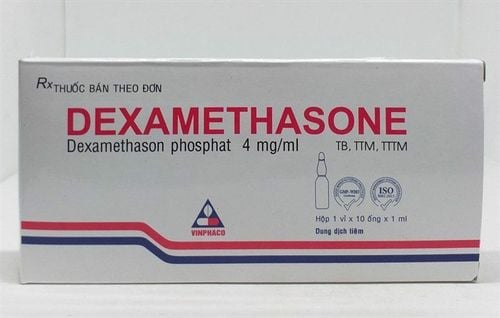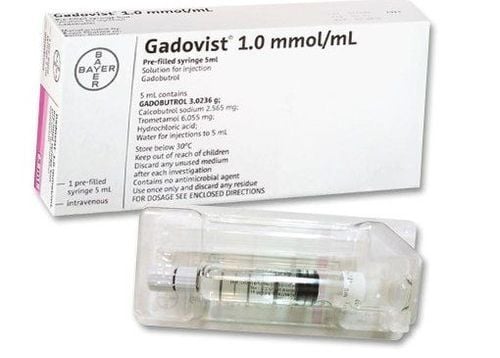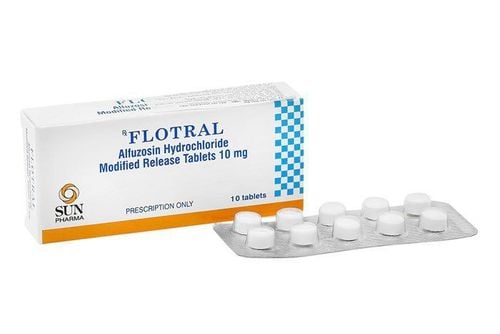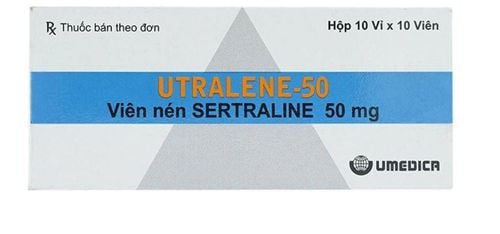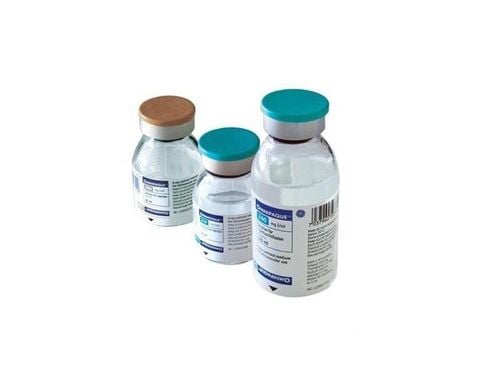This is an automatically translated article.
Dynapin is a contrast agent used by injection into a vein or empty space to make diagnosis easier. Let's find out more information about Dynapin drug through the article below.
1. What does Dynapin do?
Dynapin medicine has the main ingredient Iopromide, which is made in the form of a 50ml injection solution. Each 1 ml of drug solution contains Iopromide equivalent to Iodine 300 mg.
Iopromide is a low osmotic, non-ionizing contrast agent commonly used for intravenous administration to help diagnose disease easier and more accurate. It acts as a contrast agent by blurring the blood vessels in the flow path, allowing internal structures to be visualized.
It is often used in diagnostics using X-rays such as X-rays of parts of the urinary system such as kidneys, ureters, bladder; Brain computed tomography (CT) scans and computed tomography pulmonary vasculature (CTPAs).
When injected into the blood vessels, the drug will be distributed in the vascular system and the intercellular area, without significantly increasing blood volume and not causing disturbances in hemodynamic balance. The drug can also be injected topically and when in the body Iopromide is not metabolized.
2. Indications and contraindications for taking Dynapin
Indications: Dynapin is used intravenously or injected into body cavities to increase contrast in the following cases:
Computed tomography (CT); X-ray of arteries and veins; Background digitized angiography (DSA); Intravenous urography (UIV) and retrograde cholangiopancreatography (ERCP); X-ray of the knee joint and body cavities. Contraindications:
The use of this drug is contraindicated for people with severe hypersensitivity reactions to the components of the drug. Relative contraindications: Hyperthyroidism, pregnant women.
3. Dosage and how to use Dynapin
How to use:
The drug is used intravenously or pumped into the cavities of the body. The drug is administered by medical personnel and before use, it is necessary to carefully examine the contrast medium vials and do not use the vials that have changed color or appear foreign objects or the bottles are not intact. When intravenous contrast is administered, the patient should, if possible, be placed in the supine position for patients with impaired renal function or heart failure, for patients in poor physical condition. For these patients, renal function should also continue to be monitored for a period of 3 days after the procedure. Dosage: The patient's dose is calculated by weight by the specialist. Contrast should be used at as low an effective dose as possible, especially in patients with underlying medical conditions and at high risk for adverse events.
The recommended dose for intravenous administration is 1ml/kg body weight. The recommended dose for imaging the body's cavities is from 5 to 15 ml of Dynapin. Dosage should be adjusted according to age, weight, clinical examination and procedure technique.
4. Undesirable effects of the drug Dynapin
Some of the side effects of Dynapin include:
Nausea, vomiting, rash, pain and heat are common reactions when injected intravenously. Circulatory reactions accompanied by peripheral vasodilatation and hypotension; reflex tachycardia, dyspnea, irritability, confusion, cyanosis and may lead to loss of consciousness. Immediate emergency treatment is required. Adverse effects associated with the use of iodinated contrast media are usually mild to moderate in severity and are usually transient and then normal. However, serious adverse events that can be life-threatening have also been reported.
Immediately inform your doctor of any unwanted effects that you experience while using Dynapin.
5. Things to keep in mind when taking Dynapin
Some cases needing evaluation and caution when using Dynapin include:
Thyroid dysfunction: A risk-benefit assessment of Dynapin use is necessary for patients with disease or suspected thyroid dysfunction because iodine-containing contrast agents can cause hyperthyroidism and the risk of thyrotoxicosis in these patients. Elderly patients: Elderly patients are more likely to have cardiovascular disease and neurological disorders and often have an increased risk of adverse effects when using contrast agents. Weak patients: When using, it is necessary to carefully examine and consider carefully in cases where the patient is in poor general condition. Because hypersensitivity reactions can also occur after administration of the drug, patients should be closely monitored after the procedure. Be prepared to have emergency vehicles ready in any case. If a hypersensitivity reaction occurs, immediately discontinue use of contrast agent, treat symptomatically, provide immediate support.
Low osmotic contrast media should be used for gastrointestinal examination in infants and young children because these patients are at particularly high risk of respiratory effects, gastrointestinal obstruction. or drainage into the peritoneal cavity.
Risk of impaired renal function when using the drug: Risk factors include patients with impaired renal function, dehydration, diabetes mellitus, patients with multiple myeloma, abnormal protein levels in the blood, repeated, repeated or high doses of Dynapine. All patients receiving this drug should ensure adequate rehydration prior to contrast injection, preferably maintaining an intravenous line before and after the procedure until the contrast agent is administered. completely eliminated from the kidney.
The risk of clinical signs of hemodynamic disturbances and arrhythmias is increased in patients with established cardiac or severe coronary artery disease. In patients with vascular diseases and pulmonary hypertension, the use of contrast media may lead to hemodynamic changes, requiring monitoring.
Pregnancy: Animal studies have not shown harmful effects on pregnancy, fetal development, childbirth. However, the effect on humans is unknown, so it should not be used unless it is necessary.
Lactation: The safety of Dynapine in nursing infants has not been studied. The amount of contrast agent excreted into breast milk has been found to be very low. But the danger to a nursing infant can often be greater, so use only when necessary and breast-feeding is not recommended.
6. Interactions with other drugs
Biguanide drugs (Metformin): When used, causing transient renal dysfunction due to intravenous use of Dynapine may lead to accumulation of Biguanide group drugs and progression to metabolic lactic acidosis in patients with lactic acidosis. patients taking Biguanide. To prevent this, biguanide should be discontinued at least 48 hours before and after the administration of the contrast medium, and only resumed when renal function has returned to normal. Concomitant use with tranquilizers and antidepressants may lower the body's threshold for adverse events, thereby increasing the risk of contrast-related adverse events. lnterleukin-2: Prior treatment with lnterleukin-2 (several weeks) increases the risk of late adverse events associated with Dynapine use. Hopefully, with the above information, you know what Dynapin is used for and what you need to keep in mind when taking it. If there is an abnormality, you need to tell your doctor right away for advice.
Reference source: pharmog.com




